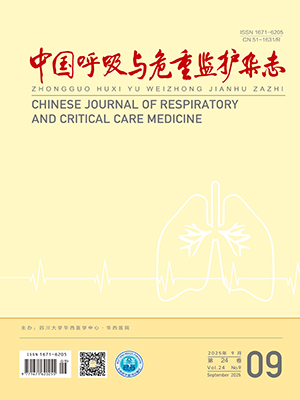| 1. |
Khunger M, Rakshit S, Pasupuleti V, et al. Incidence of pneumonitis with use of programmed death 1 and programmed death-ligand 1 inhibitors in non-small cell lung cancer: a systematic review and meta-analysis of trials. Chest, 2017, 152(2): 271-281.
|
| 2. |
Suresh K, Voong KR, Shankar B, et al. Pneumonitis in nesmall cell lung cancer patients receiving immune checkpoint immunotherapy: incidence and risk factors. J Thorac Oncol, 2018, 13(12): 1930-1939.
|
| 3. |
Haanen JBAG, Carbonnel F, Robert C, et al. Management of toxicities from immunotherapy: ESMO Clinical Practice Guidelines for diagnosis, treatment and follow-up. Ann Oncol, 2017, 28(4): 119-142.
|
| 4. |
Naidoo J, Nishino M, Patel SP, et al. Immune-related pneumonitis after chemoradiotherapy and subsequent immune checkpoint blockade in unresectable stage Ⅲ NSCLC. Clin Lung Cancer, 2020, 21(5): 435-444.
|
| 5. |
Suresh K, Psoter KJ, Voong KR, et al. Impact of checkpoint inhibitor pneumonitis on survival in NSCLC patients receiving immune checkpoint immunotherapy. J Torhae Oncol, 2019, 14(3): 494-502.
|
| 6. |
Akella P, Loganathan S, Jindal V, et al. Anti PD-1 immunotherapy related interstitial lung disease presenting as respiratory failure - A review with case series. Respir Med Case Rep, 2018, 26: 17-22.
|
| 7. |
杨彦伟, 王伟兰. 1 例帕博利珠单抗致免疫相关性肺炎的病例分析. 中国药物应用与监测, 2019, 16(2): 119-121.
|
| 8. |
李敏, 许伟, 陈艳, 等. 高龄肺腺鳞癌患者免疫治疗一例并文献复习. 中华老年医学杂志, 2020, 39(6): 689-692.
|
| 9. |
Akbari O, Stock P, Singh AK, et al. PD-L1 and PD-L2 modulate airway inflammation and iNKT-cell-dependent airway hyperreactivity in opposing directions. Mucosal Immunol, 2010, 3(1): 81-91.
|
| 10. |
Chen DS, Irving BA, Hodi FS. Molecular pathways: nextgeneration immunotherapy–inhibiting programmed death ligand 1 and programmed death-1. Clin Cancer Res, 2012, 18(24): 6580-6587.
|
| 11. |
Mizuki N, Anita GH, Hiroto H, et al, Incidence of programmed cell death 1 inhibitor–related pneumonitis in patients with advanced cancer: a systematic review and meta-analysis. JAMA Oncol, 2016, 2(12): 1607–1616.
|
| 12. |
Wu J, Hong D, Zhang X, et al. PD-1 inhibitors increase the incidence and risk of pneumonitis in cancer patients in a doseindependent manner: a meta-analysis. Sci Rep, 2017, 7: 44173.
|
| 13. |
Naidoo J, Wang X, Woo KM, et al. Pneumonitis in patients treated with anti-programmed death-1/programmed death ligand 1 therapy. J Clin Oncol, 2017, 35(7): 709-717.
|
| 14. |
Nishino M, Ramaiya NH, Awad MM, et al. PD-1 inhibitorerelated pneumonitis in advanced cancer patients: radiographic patterns and clinical course. Clin Cancer Res, 2016, 22(24): 6051-6060.
|
| 15. |
Friedman CF, Proverbs-Singh TA, Postow MA. Treatment of the immune-related adverse effects of immune checkpoint inhibitors: a review. JAMA Oncol, 2016, 2(10): 1346-1353.
|
| 16. |
Kato T, Masuda N, Nakanishi Y, et a1. Nivolumab-induced interstitial lung disease analysis of two phase Ⅱ studies patients with recurrent or advanced non-small-cell lung cancer. Lung Cancer, 2017, 104: 111-118.
|
| 17. |
Toh CK, Wong EH, Lim WT, et al. The impact of smoking status on the behavior and survival outcome of patients with advanced non-small cell lung cancer: a retrospective analysis. Chest, 2004, 126(6): 1750-1756.
|
| 18. |
Delaunay M, Cadranel J, Lusque A, et al. Immune-checkpoint inhibitors associated with interstitial lung disease in cancer patients. Eur Respir J, 2017, 50(2): 1700050.
|
| 19. |
Topalian SL, Hodi FS, Brahmer JR, et al. Safety, activity, and immune correlates of anti-PD-1 antibody in cancer. N Engl J Med, 2012, 366(26): 2443-2454.
|
| 20. |
Simonaggio A, Michot JM, Voisin AL, et al. Evaluation of readministration of immune checkpoint inhibitors after immunerelated adverse events in patients with cancer. JAMA Oncol, 2019, 5(9): 1310-1317.
|




